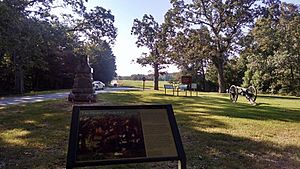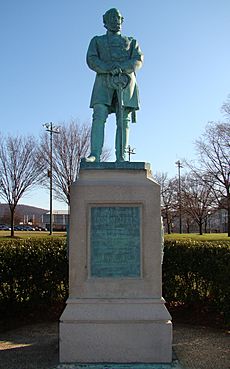John Sedgwick facts for kids
Quick facts for kids
John Sedgwick
|
|
|---|---|
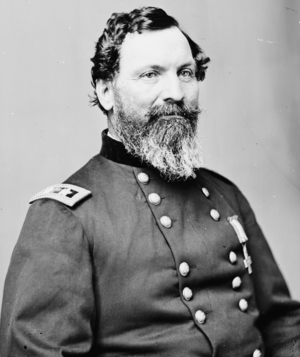
Sedgwick in the 1860s
|
|
| Nickname(s) | "Uncle John" |
| Born | September 13, 1813 Cornwall, Connecticut, U.S. |
| Died | May 9, 1864 (aged 50) Spotsylvania County, Virginia, C.S. |
| Buried |
Cornwall Hollow Cemetery (Cornwall, Connecticut)
|
| Allegiance | |
| Service/ |
United States Army Union Army |
| Years of service | 1837–1864 |
| Rank | |
| Commands held | VI Corps |
| Battles/wars | Seminole Wars Mexican–American War Utah War Indian Wars American Civil War † |
| Other work | Teacher |
| Signature | |
John Sedgwick (born September 13, 1813 – died May 9, 1864) was an important military officer. He became a Union Army general during the American Civil War.
He was hurt three times at the Battle of Antietam while leading his soldiers. This injury made him miss the Battle of Fredericksburg. Later, his group of soldiers, called the VI Corps, played a big part in the Chancellorsville Campaign. They fought bravely at the Second Battle of Fredericksburg and the Battle of Salem Church. His corps arrived late at the Battle of Gettysburg, so they did not fight much there.
General Sedgwick was killed by a sharpshooter at the Battle of Spotsylvania Court House on May 9, 1864. He was one of the highest-ranking Union generals to die in the war. He is remembered for his last words, which were a bit ironic: "They couldn't hit an elephant at this distance."
| Top - 0-9 A B C D E F G H I J K L M N O P Q R S T U V W X Y Z |
Early Life and Education
John Sedgwick was born in Cornwall, Connecticut. He was named after his grandfather, who was also a general in the American Revolutionary War. His grandfather fought alongside George Washington.
John went to Sharon Academy and Cheshire Academy. After teaching for two years, he joined the United States Military Academy in 1837. He graduated 24th in his class. He started his military career in the artillery.
Early Military Service
Sedgwick fought in the Seminole Wars. He also earned two special promotions during the Mexican–American War. These were for his bravery at the battles of Contreras, Churubusco, and Chapultepec.
After the war in Mexico, he joined the cavalry. He served in Kansas, the Utah War, and the American Indian Wars. In 1857, he was part of a mission against the Cheyenne people.
In 1860, Sedgwick led a group to build a new fort in what is now Colorado. This was a very remote place. Supplies had to travel long distances by boat, wagon, or horse. Even with many challenges, he built good stone buildings for his men before winter.
American Civil War Battles
When the American Civil War began, Sedgwick was a colonel. He was working in Washington, D.C. He missed the first big battle, the First Battle of Bull Run, because he was sick.
On August 31, 1861, he became a brigadier general. He led a brigade, which is a large group of soldiers. Later, he commanded his own division. This division was part of the II Corps in the Peninsula Campaign. In Virginia, he fought at Yorktown and Seven Pines.
During the Seven Days Battles, Sedgwick's division fought at Savage's Station and Glendale. He was wounded in the battle of Glendale. After these battles, he was promoted to major general.
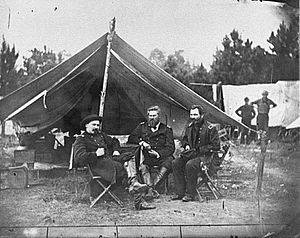
At the Battle of Antietam, Sedgwick's division was sent into a big attack without enough planning. Confederate soldiers attacked his division from three sides. His group was badly beaten and lost almost half its men. Sedgwick himself was shot three times. He was hit in the wrist, leg, and shoulder. These injuries kept him out of action for a while.
Leading the VI Corps
In late 1862, Sedgwick took command of the VI Corps. He led this group until he died in 1864.
During the Battle of Chancellorsville, his corps stayed near Fredericksburg. They held their position while other Union forces tried to attack Robert E. Lee's army. Sedgwick was slow to act, but he eventually crossed the Rappahannock River. On May 3, he attacked a smaller Confederate force at Marye's Heights during the Second Battle of Fredericksburg.
He then moved west to join other Union forces. The goal was to trap Lee's army. But he was stopped by Confederate soldiers at the Battle of Salem Church. This forced him to retreat back across the Rappahannock River.
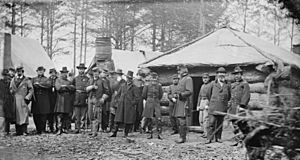
At the Battle of Gettysburg, his corps arrived late on July 2. Only a few of his units could join the Union counterattacks in the Wheatfield. His corps was split up to fill gaps in the Union lines.
Even though his corps was mostly held back at Gettysburg, they fought very well at the Second Battle of Rappahannock Station in November. They captured many cannons, flags, and 1,700 prisoners.
Before the Overland Campaign in 1864, some generals were replaced. Sedgwick almost lost his command. He was tired of the war and wanted to go home to New England. But he stayed in charge of the VI Corps. In the Overland Campaign, his corps fought on the right side of the Union army at the Battle of the Wilderness.
Death of a General
Sedgwick died at the start of the Battle of Spotsylvania Court House on May 9, 1864. His soldiers were checking the enemy lines. He was directing where to place cannons. Confederate sharpshooters were about 1,000 yards away. Their shots made his staff and artillerymen duck for cover.
Sedgwick walked around in the open, not hiding. He famously said, "What? Men dodging this way for single bullets? What will you do when they open fire along the whole line?" His men kept flinching, and he added, "Why are you dodging like this? They couldn't hit an elephant at this distance." Moments later, he was shot by a Whitworth rifle under his left eye and died.
His chief of staff, Martin T. McMahon, said the bullets were whistling around them. He remembered saying, "General, they are firing explosive bullets." But then Sedgwick's face turned, and blood spurted from his cheek. He fell, and McMahon tried to catch him. Sedgwick never woke up and bled for some time.
Sedgwick was the highest-ranking Union general to die in the Civil War. When Lt. Gen. Ulysses S. Grant heard the news, he was shocked. He kept asking, "Is he really dead?"
Legacy and Memory
General Sedgwick was known as a steady and reliable leader. His soldiers liked him a lot and called him "Uncle John." Everyone was sad when he died. Even Robert E. Lee, the Confederate general, felt sad for his old friend. George G. Meade, another Union general, cried when he heard the news.
Ulysses S. Grant said that Sedgwick "was never at fault when serious work was to be done." He told his staff that losing Sedgwick was worse than losing an entire division of soldiers.
Sedgwick is buried near his hometown in Cornwall Hollow, Connecticut. There is a statue of him and the VI Corps at Gettysburg National Military Park.
There is also a monument of General Sedgwick at West Point. A fun legend at the Academy says that if a cadet spins the spurs on the statue's boots at midnight, they will have good luck on their final exam.
Many places were named in his honor, including:
- Sedgwick, Colorado
- Sedgwick County, Colorado
- Sedgwick, Kansas
- Sedgwick County, Kansas
- Fort Sedgwick, a fort used during the Siege of Petersburg in 1864–65.
- Camp Rankin, which was renamed Fort Sedgwick in 1865, near Julesburg, Colorado.
A major street in the Bronx, New York City, is named after him. There is also a street named after him in Washington, D.C., and another in Chicago. A train station in Chicago is also named after the street. Several groups of Civil War veterans, called Grand Army of the Republic Posts, were named after him. A middle school in Port Orchard, Washington, is also named John Sedgwick Middle School.
His headquarters at the time of the Battle of Brandy Station, a place called Farley, is now a historic site.
See also
 In Spanish: John Sedgwick para niños
In Spanish: John Sedgwick para niños



